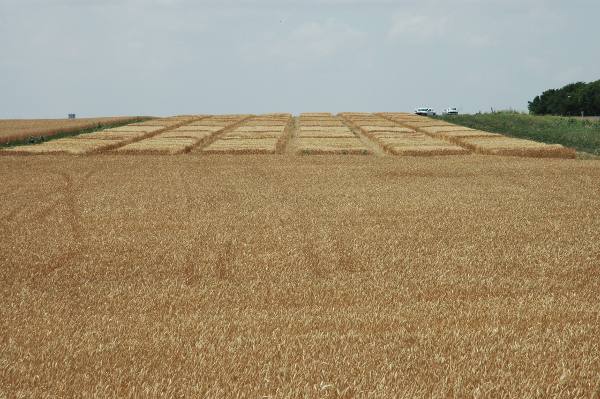
When the Texas A&M Agricultural Experiment Station at Prosper, Texas, converted from agriculture to turf and ornamental research about five years ago, Northeast and Central Texas farmers lost a valuable resource that had been geared to the unique soils and climate conditions of their region.
Farmers say the small grains variety trials (especially for wheat), fertility studies and research on herbicide resistant Italian ryegrass, among other projects, had provided essential information to help them make production decisions.
Since the center converted to urban agriculture, research and variety trials have been scattered across the region—on leased acreage, cooperator fields and wherever scientists could find a spot with the right conditions to install research plots.
Northeast Texas farmers say they need a farm.
That’s why a group of farmers and ag business leaders, spearheaded by Cereal Crops Research Incorporated (CCRI), has begun work to bring a research farm back to the region under the auspices of Texas A&M-Commerce, with support from Texas A&M University at College Station.
CCRI is a farmer-based organization that suggests and helps fund research for Northeast Texas agriculture. Over the past 25 years, the organization has contributed more than $1 million to ag research for Northeast Texas. They would like to do more.
“We no longer have an ag research location in Northeast Texas. That’s the biggest absence farmers in this area feel,” says Ben Scholz, CCRI president and a Distinguished Alumnus of Texas A&M-Commerce.
“We lost ag research at Prosper at least five years ago, where they were doing small grain evaluations as well as work on corn and grain sorghum and resistant weeds. Now, we have no permanent site but are renting and borrowing locations across Northeast Texas. We need a location to provide consistency for research into cotton, grains, forages and specialty crops like viticulture and vegetables.”
Eric Akins, a grain farmer near Van Alstyne, Texas, says area farmers received significant benefits from research and field days once held at the Prosper station. “We got a lot of variety information from work at Prosper,” he said. “They also did fertility research.”
Those soil nutrient evaluations require multiple years of trials on the same plots. “Consistency is essential,” he added.
Kenneth Griffin, a Gunter, Texas, grain farmer, agrees. “We need to look at all types of fertility issues—foliar, everything—so we need consistency.”
The same is true for herbicide resistance evaluations. The area has had severe infestations of herbicide resistant Italian ryegrass. “Researchers can’t spread resistant ryegrass across a cooperator’s farm,” says David Smith, who manages a nearby grain elevator.
Consistency is needed
“We need the ability to look at things long-term,” Griffin added.
They say the soils and climate of Northeast Texas and the Blacklands are unique. “The structure of the soils in this area is vastly different from soils in other areas,” Akins says. “We have a lot of questions about nutrients sequestered in the soil, for instance. What’s there and can we get it? And how do we take advantage of it if it is available?”
Jay Norman, who farms near Wolfe City, Texas, says aflatoxin research is another area that demands a localized, consistent test site for long-term research. “We have a pretty good handle on aflatoxin now,” he says. Recent adoption of atoxigenic strains of the aspergillus fungus by many Northeast Texas and Blacklands corn farmers has reduced aflatoxin levels significantly, but ongoing research is necessary, Norman says, to maintain the progress. And aflatoxin is not something cooperator farmers want added to their soils.
“We need a permanent site for this kind of research,” Scholz says. “Some projects take years before scientists can develop the data we need to make production decisions.”
Norman says farmers in Northeast Texas, as well as anywhere in the country, need a source of “unbiased, university research. It’s critical.”
“I can’t even guess at the number of products pushed on us every year without credible testing,” Akins says. “It’s all snake oil until it’s tested and until it works.”
Proponents of the research farm are not asking for a large, state-of-the art research center. They can do without elaborate office buildings, laboratories and other facilities available at some experiment stations. “We need from 150 to 200 acres, preferably near Texas A&M-Commerce for easy student access,” Scholz says. “We need only minimal facilities, such as equipment sheds and barns. Scientists from other locations across the state can bring some of their trials here. At one time, it may have been necessary to have scientists on-site. That’s no longer the case.”
He says a verbal commitment for funding for the farm was made several years ago by Texas A&M-Commerce, with indications of research support from College Station.
“Our next step is to get all the stakeholders together to develop a strategic plan and then agree to locate a farm and secure it,” Scholz says. “We need to get all the stakeholders to participate.” Stakeholders include Texas A&M-Commerce, Texas AgriLife Extension, Texas AgriLife Research, scientists headquartered at College Station, CCRI, regional farmers and other related ag industries.
Ag students at A&M-Commerce are among the stakeholders in a research farm. Students have an option of taking an ag practicum class that offers credit for making a crop. Students get seed money from CCRI and currently use leased land near the university to plant, manage and harvest a crop. If they make a profit, they keep the proceeds, after repaying the seed money. Scholz says that program is a unique opportunity for A&M-Commerce students, and one of only three such programs in the country.
Currently, CCRI and other stakeholders are routing a petition to farmers, ranchers, bankers, farm suppliers, and a few legislators asking for support for the project. “We hope to get signatures representing 1 million acres,” Scholz says
“We know it’s good for the region, for what we do,” Akin says. “And for those who come after us, it will be critical.”
About the Author(s)
You May Also Like






